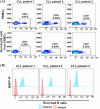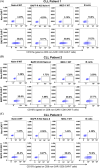Targeting chronic lymphocytic leukemia with B-cell activating factor receptor CAR T cells
- PMID: 39224539
- PMCID: PMC11366826
- DOI: 10.1002/mco2.716
Targeting chronic lymphocytic leukemia with B-cell activating factor receptor CAR T cells
Abstract
The challenge of disease relapsed/refractory (R/R) remains a therapeutic hurdle in chimeric antigen receptor (CAR) T-cell therapy, especially for hematological diseases, with chronic lymphocytic leukemia (CLL) being particularly resistant to CD19 CAR T cells. Currently, there is no approved CAR T-cell therapy for CLL patients. In this study, we aimed to address this unmet medical need by choosing the B-cell activating factor receptor (BAFF-R) as a promising target for CAR design against CLL. BAFF-R is essential for B-cell survival and is consistently expressed on CLL tumors. Our research discovered that BAFF-R CAR T-cell therapy exerted the cytotoxic effects on both CLL cell lines and primary B cells derived from CLL patients. In addition, the CAR T cells exhibited cytotoxicity against CD19-knockout CLL cells that are resistant to CD19 CAR T therapy. Furthermore, we were able to generate BAFF-R CAR T cells from small blood samples collected from CLL patients and then demonstrated the cytotoxic effects of these patient-derived CAR T cells against autologous tumor cells. Given these promising results, BAFF-R CAR T-cell therapy has the potential to meet the long-standing need for an effective treatment on CLL patients.
Keywords: BAFF‐R; B‐cell malignancies; CAR T cells; chronic lymphocytic leukemia; immunotherapy.
© 2024 The Author(s). MedComm published by Sichuan International Medical Exchange & Promotion Association (SCIMEA) and John Wiley & Sons Australia, Ltd.
Conflict of interest statement
H. Qin has equity ownership with Pepromene Bio Inc. The remaining authors declare they have no conflicts of interest.
Figures








References
-
- Siegel RL, Miller KD, Wagle NS, Jemal A. Cancer statistics, 2023. CA Cancer J Clin. 2023;73(1):17‐48. - PubMed
-
- Hallek M, Cheson BD, Catovsky D, et al. iwCLL guidelines for diagnosis, indications for treatment, response assessment, and supportive management of CLL. Blood. 2018;131(25):2745‐2760. - PubMed
-
- Munir T, Cairns DA, Bloor A, et al. Chronic lymphocytic leukemia therapy guided by measurable residual disease. N Engl J Med. 2024;390(4):326‐337. - PubMed
-
- Ghia P, Pluta A, Wach M, et al. ASCEND: phase III, randomized trial of acalabrutinib versus idelalisib plus rituximab or bendamustine plus rituximab in relapsed or refractory chronic lymphocytic leukemia. J Clin Oncol. 2020;38(25):2849‐2861. - PubMed
LinkOut - more resources
Full Text Sources
